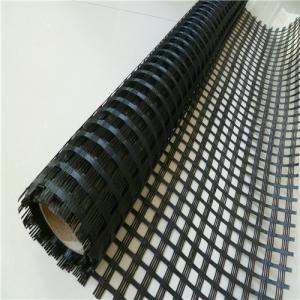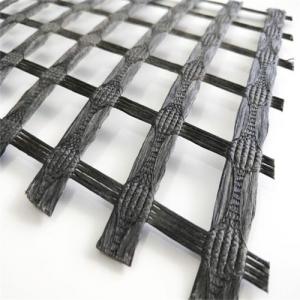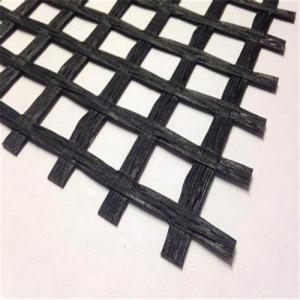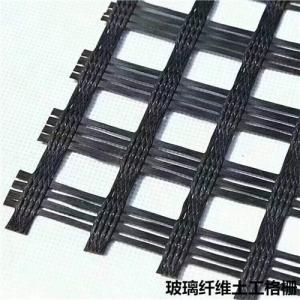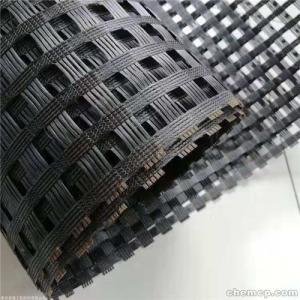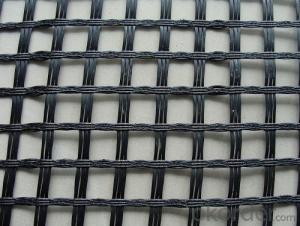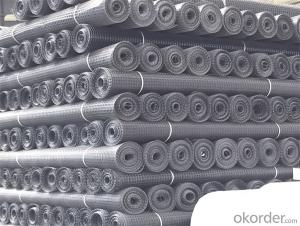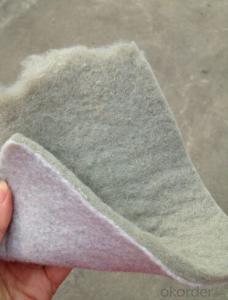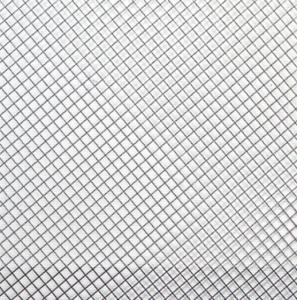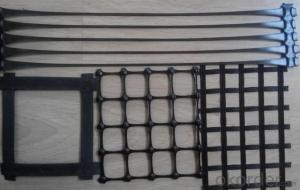Fiberglass Geogrid with High Tensile Strength Warp Knitted
- Loading Port:
- Qingdao
- Payment Terms:
- TT or LC
- Min Order Qty:
- 20000 m²
- Supply Capability:
- 50000000 m²/month
OKorder Service Pledge
OKorder Financial Service
You Might Also Like
Fiberglass Geogrid Introduction:
Fiberglass geogrid is a kind of planar mesh material using alkalifree fiberglass yarn as base body and then coated with high quality modified asphalt. It is warp knitted with oriental structure which gives full play of yarn strength and improves its mechanical property to make the product high tensile, tearing and creep resistant. Moreover, the composite property of coating with asphalt makes full protection of the fiberglass matrix and greatly improves its wear and shear resistance. All the advantageous functions make the product have a good performance in pavement strengthening, track cracking and solving difficulties of strengthening the bituminous pavement.
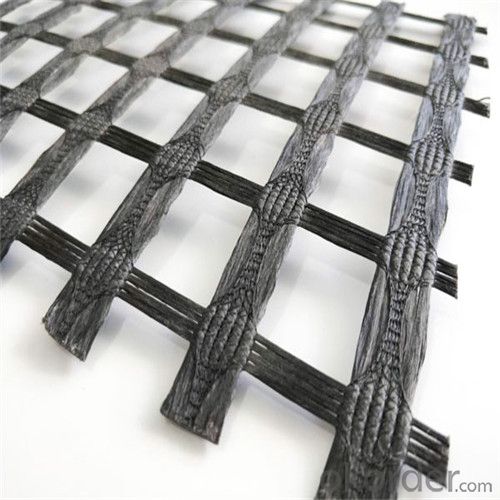
Fiberglass Geogrid Specification:
Specifications | FG20-20 | FG30-30 | FG40-40 | FG50-50 | FG80-80 | FG100-100 | FG120-120 |
Elongation(%) | 4% | ||||||
Vert Tensile strength(KN/m) | 20 | 30 | 40 | 50 | 80 | 100 | 120 |
Horiz Tensile strength(KN/m) | 20 | 30 | 40 | 50 | 80 | 100 | 120 |
Grid(mm) | 12.5×12.5 20×20 24.5×24.5 | ||||||
Width(m) | 1—6 | ||||||
Fiberglass Geogrid Features:
1. Light weight, high tensile strength, high modulus, low elongation and good toughness.
2. Corrosion resistance, no long-term creep, long life span.
3. Good physical and chemical stability and good thermal stability.
4. Resistant to fatigue cracking, high-temperature track and low temperature shrinkage cracking.
5. Delaying and decreasing crack reflection.
Fiberglass Geogrid Application:
1. Road surface asphalt overlay construction engineering; Asphalt layers reinforcement.
2. Converting old cement concrete road into composite road; Restraining reflection cracking caused by block shrinkage.
3. Road extension; Preventing and controlling the cracking caused by new and old combination and uneven settlement.
4. Treatment of the conjunction between tunnel and bridge or foundation.
FAQ:
1. How to order your geogrid ?
a) Tensile strength in warp & weft direction
b) Grid size
c) Roll Width and length
d) Quantity
2. What is the Payment term?
a) TT
b) LC AT SIGHT
c) cash
d) 30% contact value as deposit ,the blance 70% be paid after received the copy of bl .
3. Delivery time
a) 19-25 days after received your depsit .
4. What is MQQ ?
a) 2500 m2 as MQQ , we can also produce sample for you .
Welcome to send your inquiry to us, and if you have any question, we can also help you.
- Q:Are geogrids resistant to freeze-thaw cycles?
- Yes, geogrids are generally resistant to freeze-thaw cycles. Their material composition and design allow them to withstand the expansion and contraction caused by freezing and thawing temperatures without significant damage. This resistance makes geogrids suitable for various applications in cold climates where freeze-thaw cycles are common.
- Q:What is the recommended installation method for geogrids?
- The recommended installation method for geogrids is to ensure proper preparation of the subgrade, followed by unrolling the geogrid on top and securing it with stakes or pins. It is important to overlap the geogrid panels correctly and avoid any wrinkles or folds. Finally, cover the geogrid with the desired fill material and compact it properly to maximize the effectiveness of the geogrid.
- Q:How do geogrids improve the performance of asphalt pavements?
- Geogrids improve the performance of asphalt pavements by providing reinforcement and stability. They effectively distribute the load across the pavement structure, reducing cracking and rutting. Additionally, geogrids enhance the overall strength and durability of the pavement, thus extending its lifespan and reducing maintenance costs.
- Q:What is a geogrid?
- A geogrid is a type of synthetic material made from polymers, typically used in civil engineering and construction applications. It is a grid-like structure with open spaces that allow for soil or aggregate to interlock with the grid, providing reinforcement and stability to the ground. Geogrids are commonly used to enhance the strength and load-bearing capacity of soil, preventing soil erosion and improving the performance of structures such as retaining walls, roads, and embankments.
- Q:Are geogrids suitable for use in ground reinforcement for agricultural facilities?
- Yes, geogrids are suitable for use in ground reinforcement for agricultural facilities. Geogrids provide effective soil stabilization, erosion control, and load-bearing capabilities, making them ideal for reinforcing agricultural areas such as access roads, parking lots, and storage areas. They help distribute the load evenly, prevent soil compaction, and improve overall drainage, resulting in increased durability and longevity of the facilities.
- Q:What is the recommended spacing between geogrid layers?
- The recommended spacing between geogrid layers can vary depending on the specific project and soil conditions. However, in general, a spacing of about 2 to 3 feet (0.6 to 0.9 meters) is often recommended to achieve optimal reinforcement and stability.
- Q:How do geogrids prevent soil erosion?
- Geogrids prevent soil erosion by providing reinforcement and stability to the soil. These synthetic materials are installed within the soil to form a strong, interconnected network that improves the soil's shear strength. This reinforcement prevents the soil particles from being washed away by water or blown away by wind, effectively reducing erosion.
- Q:What are the advantages of using geogrids in ground improvement for settlement control?
- Geogrids offer several advantages in ground improvement for settlement control. Firstly, they provide increased soil stability by distributing loads more evenly, thereby reducing settlement and preventing soil erosion. Secondly, geogrids enhance soil reinforcement, increasing the bearing capacity of the ground and allowing for the construction of heavier structures. Additionally, these materials are easy to install and cost-effective, saving time and money during the ground improvement process. Overall, geogrids offer a reliable and efficient solution for settlement control and improved ground stability.
- Q:Can geogrids be used in reinforced earth bridge piers?
- Yes, geogrids can be used in reinforced earth bridge piers. Geogrids are commonly used as reinforcement materials in soil structures, including bridge piers. They help improve the stability and strength of the soil, enabling it to withstand the loads and pressures exerted on the bridge piers.
- Q:How much is the horizontal overlap length of the steel plastic geogrid
- It should be 20cm to 40cm, it's a little longer
1. Manufacturer Overview |
|
|---|---|
| Location | |
| Year Established | |
| Annual Output Value | |
| Main Markets | |
| Company Certifications | |
2. Manufacturer Certificates |
|
|---|---|
| a) Certification Name | |
| Range | |
| Reference | |
| Validity Period | |
3. Manufacturer Capability |
|
|---|---|
| a)Trade Capacity | |
| Nearest Port | |
| Export Percentage | |
| No.of Employees in Trade Department | |
| Language Spoken: | |
| b)Factory Information | |
| Factory Size: | |
| No. of Production Lines | |
| Contract Manufacturing | |
| Product Price Range | |
Send your message to us
Fiberglass Geogrid with High Tensile Strength Warp Knitted
- Loading Port:
- Qingdao
- Payment Terms:
- TT or LC
- Min Order Qty:
- 20000 m²
- Supply Capability:
- 50000000 m²/month
OKorder Service Pledge
OKorder Financial Service
Similar products
New products
Hot products
Hot Searches
Related keywords
